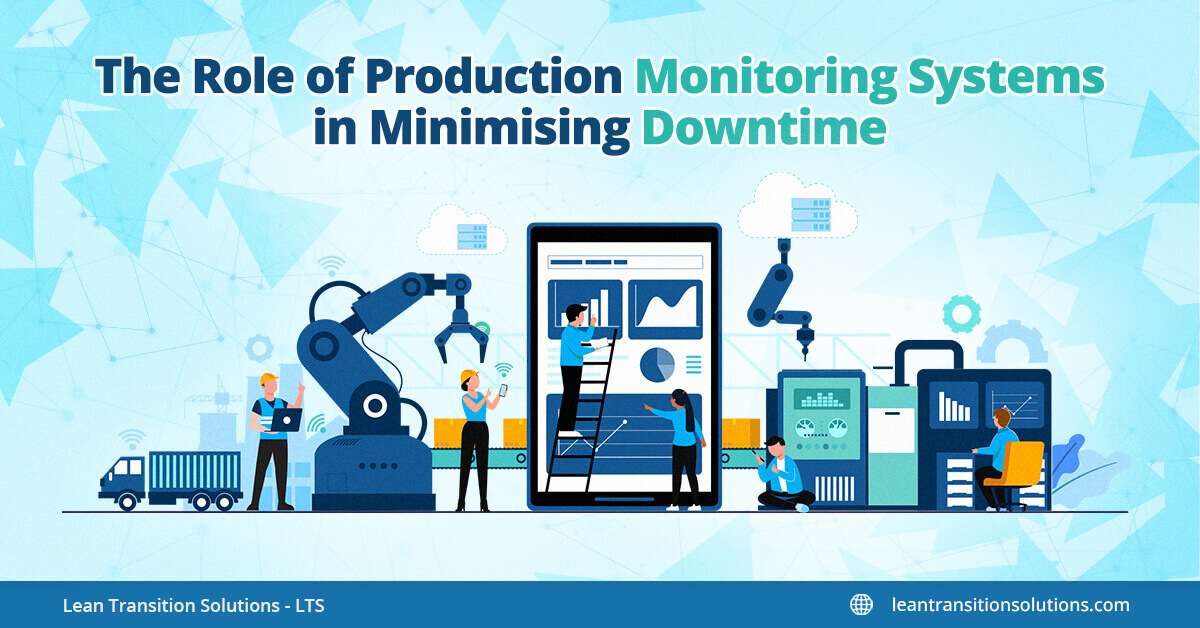How can a Production Monitoring System minimise downtime?
October 6, 2025
In today’s fast-paced manufacturing environment, minimising downtime is critical for maintaining productivity and profitability. Unexpected equipment failures, inefficient processes, and unplanned stoppages can lead to significant losses. But how can manufacturers effectively reduce downtime? This is where production monitoring systems play a vital role.
By leveraging real-time data collection and analytics, production monitoring systems help manufacturers identify inefficiencies, predict equipment failures, and make informed decisions to keep operations running smoothly. Let’s explore how these systems work and why they are essential for minimising downtime on the shop floor.
By leveraging real-time data collection and analytics, production monitoring systems help manufacturers identify inefficiencies, predict equipment failures, and make informed decisions to keep operations running smoothly. Let’s explore how these systems work and why they are essential for minimising downtime on the shop floor.
What causes downtime in manufacturing?
Before looking at solutions, it’s important to understand the root causes of downtime. Some of the most common issues include:
- Equipment failures— Machines breaking down unexpectedly due to wear and tear, improper maintenance, or undetected faults.
- Process inefficiencies— Bottlenecks, delays, and mismanagement in production workflows leading to wasted time.
- Labour shortages and human errors— Mistakes in setup, operation, or scheduling that result in stoppages.
- Supply chain disruptions— Delays in material deliveries affecting production continuity.
- Unplanned maintenance— Reactive rather than preventive maintenance causing sudden downtime.
How does a production monitoring system help reduce downtime?
A production monitoring system continuously tracks machine performance, production rates, and downtime incidents in real time. But how does this translate into reduced downtime? Here are some keyways:
- Real-time visibility into production processes – Operators and managers can see live data on machine performance, identifying any potential slowdowns before they escalate.
- Predictive maintenance – By analysing equipment data, the system can detect signs of wear and alert teams to schedule maintenance before a failure occurs.
- Faster response times – When a problem arises, automated alerts ensure that the right personnel are notified immediately, reducing the time taken to diagnose and fix the issue.
- Optimised roduction scheduling – By understanding machine performance trends, businesses can adjust production schedules to prevent unnecessary stoppages.
Can production monitoring systems help identify recurring issues?
Yes! One of the most valuable aspects of a production monitoring system is its ability to highlight recurring downtime patterns. Through historical data analysis, manufacturers can identify trends and root causes of stoppages.
For example, if a specific machine consistently experiences breakdowns at certain times, the data can pinpoint whether the issue is linked to operator handling, maintenance schedules, or an underlying technical fault. By addressing the root cause rather than just the symptoms, manufacturers can significantly reduce unplanned downtime.
For example, if a specific machine consistently experiences breakdowns at certain times, the data can pinpoint whether the issue is linked to operator handling, maintenance schedules, or an underlying technical fault. By addressing the root cause rather than just the symptoms, manufacturers can significantly reduce unplanned downtime.
What role does automation play in downtime reduction?
Automation is a game-changer for minimising downtime, and production monitoring systems are a key part of this transformation.
- Automated alerts and notifications – Instant alerts allow teams to act quickly before minor disruptions turn into major problems.
- AI-driven analytics – Advanced algorithms can predict potential failures, helping manufacturers switch from reactive to proactive maintenance.
- Integration with shop floor systems – Production monitoring systems can connect with shop floor data collection software, ERP, and MES platforms, providing a complete view of operations and improving decision-making.
How can manufacturers get the most out of a production monitoring system?
To maximise the benefits of a production monitoring system, manufacturers should:
- Ensure all critical machines are connected – Capturing data from the most important equipment helps in making informed decisions.
- Train staff to use insights effectively – Providing training on how to interpret and act on the data ensures smoother operations.
- Continuously refine maintenance strategies – Using system-generated insights to adjust maintenance schedules and optimise performance.
- Integrate with other shop floor solutions – A production monitoring system works best when it’s part of a broader digital transformation strategy.
Reduce downtime with intelligent shop floor data collection
A production tracking system is more than just a tool for tracking downtime—it’s a powerful solution for enhancing efficiency, improving maintenance strategies, and driving continuous improvement.
If you’re looking for a way to gain real-time visibility and actionable insights into your shop floor operations, Janus data capture our shop floor data collection software provides a complete solution. Designed to help manufacturers reduce downtime, improve performance, and optimise production, it ensures you stay ahead in today’s competitive market.
Want to see it in action? Explore our shop floor data collection software and discover how it can transform your operations.
If you’re looking for a way to gain real-time visibility and actionable insights into your shop floor operations, Janus data capture our shop floor data collection software provides a complete solution. Designed to help manufacturers reduce downtime, improve performance, and optimise production, it ensures you stay ahead in today’s competitive market.
Want to see it in action? Explore our shop floor data collection software and discover how it can transform your operations.
FAQs
1. How to track and reduce downtime in production?
Use production monitoring software to log downtime in real time, identify causes, and implement targeted corrective actions.
2. What is Production Monitoring and Control (MPC)?
MPC is a system that tracks, records, and manages real-time production activities to ensure efficiency and quality.
3. How does a production monitoring system help manufacturers?
It provides real-time visibility into machine performance, highlights bottlenecks, and supports data-driven decision-making.
4. Does production monitoring software generate machine downtime analysis reports?
Yes, it automatically collects and analyses downtime data, offering detailed reports to improve uptime and productivity.
5. What are production monitoring tools?
These include sensors, data collection systems, dashboards, and software platforms like Janus Data Capture that track and optimise shop floor operations.
Use production monitoring software to log downtime in real time, identify causes, and implement targeted corrective actions.
2. What is Production Monitoring and Control (MPC)?
MPC is a system that tracks, records, and manages real-time production activities to ensure efficiency and quality.
3. How does a production monitoring system help manufacturers?
It provides real-time visibility into machine performance, highlights bottlenecks, and supports data-driven decision-making.
4. Does production monitoring software generate machine downtime analysis reports?
Yes, it automatically collects and analyses downtime data, offering detailed reports to improve uptime and productivity.
5. What are production monitoring tools?
These include sensors, data collection systems, dashboards, and software platforms like Janus Data Capture that track and optimise shop floor operations.
